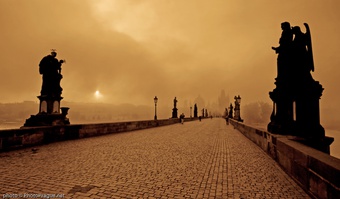
Charles Bridge
* * *The Charles Bridge is a world-renowned monument and it is the oldest bridge crossing the Vltava River.
In 1342, chunks of ice floating on the river irreparably destroyed the Judith Bridge, which was a unique bridge dating from the early Middle Ages. After its destruction and in order to preserve his control over the crossing of the river, Emperor Charles initiated the construction of a new stone bridge. As a result, the emperor himself laid the foundation stone in 1357, thus launching the construction work. According to the latest theories, the first master constructor was the stonecutter and burgher Otlin, who was replaced after his death by the designer of the St Vitus Cathedral, the highly skilled Peter Parler, originally from Swabia. He was able to combine his classical knowledge with the use of new elements (extended keystone, net vault) and basically handled the building of the bridge to its completion, even though he didn’t live to see it.
The bridge was completed with the building of the Lesser Quarter tower in 1411. It was 516 meters long and about 9,4 meters wide. It has a total of 16 bridge-arches and was designed so as to withstand floods much better than the previous Judith Bridge. As it happens it had to hold off unusually frequent floods all through its building.
An analysis of the mortar confirmed that the legend about eggs being used to strengthen it was actually true.
In 1393, the body of the tortured to death Vicar John of Nepomuk was thrown down from the bridge, a commemorative cross marks the spot where the event took place.
The bridge soon became the heart of the city’s life and trade. At the beginning of the Thirty Years War, it witnessed an infamous scene when Emperor Ferdinand II had the 12 heads of the executed Bohemian lords and leaders of the Estates rebellion hung at the top of the Bridge Tower. By the end of that same war it witnessed the resistance of the Prague inhabitants against the assaulting Swedes, in which occasion the latter stole the last Gothic ornaments of the bridge.
The following Baroque stage of the construction of the bridge endeavored to remedy to this fact. During this stage, the bridge was adorned with a wide range of beautiful Baroque sculptures. They
are mainly composed of 30 Baroque statues, together with several Classic and neo-Gothic statues from the 19th century. The decoration was inspired by the gallery of statues on the Bridge of Angels in Rome.
In 1683, the statue on John of Nepomuk, probably made by Jan Brokoff, was added on the bridge. Ten years later, the artist resumed his work with the sculpture of the Lamenting of the Christ. Between 1706 and 1714, the project of a statue gallery was greatly developed and more than 26 statues were made by leading sculptors during this short period (M.B. Braun, F.M. Brokoff, F. Preiss and others).
The first oil streetlights were placed on the bridge in 1723 and were replaced in 1866 by gaslights.
In 1890, the bridge withstood one of the worst floods, when drifting wood caused the fall of 3 bridge-arches and the loss of Brokoff’s statues of St. Ignatius and St Francis Xavier. But the bridge could be repaired and put back into use.
In 1965-1967 a general restoration of the bridge was undertaken, after which the bridge became reserved to pedestrians.
In 2001, discussions were initiated about the renewed restoration of the bridge, primarily regarding its hydro-insulation, which was supposed to prevent the rain from sinking in the structure, and a ferroconcrete panel was talked about, which would strengthen the structure and thus protect the bridge in case of floods. The resistance of the bridge against floods was however proved the following year when the monument withstood the great flood without much damage, after which the idea of the panel was abandoned. The latest version of restoration plans was eventually launched in 2007 and it is much more respectful, primarily of the original medieval structure, than the previous plans. But as was pointed out by the Klub Za starou Prahu (Association for the preservation of the old Prague), it still isn’t optimal. The critique aims mainly at the quality of the stonecutting work in general and the quality of the work executed by the supplier, which can be very well seen from the Manes Bridge.
The Charles Bridge remains even today one of the greatest monuments you can visit in the Czech Republic and it can be seen as the display window of several art styles.
























